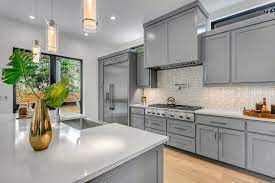Refacing kitchen cabinets is a popular way to update the look of your kitchen without the expense and time involved in a complete remodel. However, like any home improvement project, refacing kitchen cabinets can come with its own set of challenges. In this article, we will discuss common problems with refacing kitchen cabinets and how to fix them.
Problem #1: Peeling or Chipping Veneer
Veneer is a thin layer of wood that is applied to the surface of the cabinet doors and drawers during the refacing process. Over time, veneer can begin to peel or chip, creating an unsightly and potentially hazardous situation. To fix this problem, you will need to remove the damaged veneer and replace it with a new layer.
To remove the damaged veneer, use a putty knife or scraper to gently pry it away from the surface of the cabinet. Be careful not to damage the underlying wood. Once the veneer has been removed, use sandpaper to smooth the surface of the wood. Then, apply a new layer of veneer using contact cement. Allow the cement to dry completely before trimming the excess veneer with a utility knife.
Problem #2: Warped or Misaligned Doors
Warped or misaligned cabinet doors can be a frustrating and unsightly problem. This issue can be caused by changes in humidity, improper installation, or wear and tear over time. To fix this problem, you will need to adjust or replace the hinges on the affected doors.
To adjust the hinges, use a screwdriver to loosen the screws that hold the hinge in place. Then, adjust the position of the door until it is level and aligned with the other doors. Once the door is properly aligned, tighten the screws to hold the hinge in place.
If the hinges are damaged or worn, you may need to replace them. To do this, remove the old hinges using a screwdriver and replace them with new ones. Be sure to choose hinges that are the same size and style as the old ones to ensure a proper fit.
Problem #3: Stains or Discoloration
Stains or discoloration on the surface of the cabinet doors can be caused by exposure to heat, moisture, or chemicals. To fix this problem, you will need to remove the stain or discoloration and refinish the surface of the cabinet.
To remove the stain or discoloration, use a wood cleaner or a mixture of vinegar and water to clean the surface of the cabinet. If the stain is particularly stubborn, you may need to use a wood bleach to lighten the color of the wood. Be sure to follow the manufacturer’s instructions carefully when using a wood bleach.
Once the surface of the cabinet is clean and free of stains, you can refinish it using a wood stain or paint. Be sure to choose a product that is designed for use on cabinets and follow the manufacturer’s instructions carefully. You may need to apply multiple coats of stain or paint to achieve the desired finish.
Problem #4: Loose or Wobbly Drawer Fronts
Loose or wobbly drawer fronts can be caused by loose screws, damaged or worn drawer slides, or an improperly installed drawer. To fix this problem, you will need to identify the cause of the issue and make the necessary repairs.
If the screws that hold the drawer front in place are loose, use a screwdriver to tighten them. If the screws are damaged or worn, replace them with new ones. Be sure to choose screws that are the same size and style as the old ones to ensure a proper fit.
If the drawer slides are damaged or worn, you may need to replace them. To do this, remove the old slides using a screwdriver and replace them with new ones. Be sure to choose slides that are the same size and style as the old ones to ensure a proper fit.
If the drawer was not installed properly, you may need to adjust it to ensure that it is level and aligned with the other drawers. To do this, use a screwdriver to loosen the screws that hold the drawer in place. Then, adjust the position of the drawer until it is level and aligned with the other drawers. Once the drawer is properly aligned, tighten the screws to hold it in place.
Problem #5: Peeling or Bubbling Laminate
Laminate is a popular choice for cabinet refacing because it is durable and easy to clean. However, over time, laminate can begin to peel or bubble, creating an unsightly and potentially hazardous situation. To fix this problem, you will need to remove the damaged laminate and replace it with a new layer.
To remove the damaged laminate, use a putty knife or scraper to gently pry it away from the surface of the cabinet. Be careful not to damage the underlying wood. Once the laminate has been removed, use sandpaper to smooth the surface of the wood. Then, apply a new layer of laminate using contact cement. Allow the cement to dry completely before trimming the excess laminate with a utility knife.
In conclusion, refacing kitchen cabinets can be a great way to update the look of your kitchen without the expense and time involved in a complete remodel. However, it is important to be aware of the potential problems that can arise during the refacing process and to know how to fix them. By addressing these issues promptly and properly. You can ensure that your refaced cabinets will look beautiful and function well for years to come.

